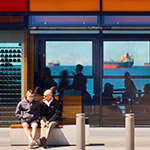What once was a low-slung concession stand on a Vancouver beach is now Canada’s first LEED Gold restaurant. With mountain views to the east and the city’s most popular Pacific Ocean beach to the west, patrons of the Cactus Club Café at English Bay deserved a space that maximized these surroundings, and West Coast-style architecture—a modernist post-and-beam vernacular characterized by roof overhangs and glass walls—was the perfect fit.
It took a good deal of effort, however, to keep sightlines clear, according to the building’s architects. Mark Ostry and Derek Fleming, both of Vancouver-based Acton Ostry Architects, say that a big part of their final solution was placing building mechanicals, restrooms, and the kitchen underground. Building components above ground was also a challenge but solved through a minimalist approach that exploits Vancouver’s sumptuous topography.
The restaurant replaced a banal park board concession structure, and the City of Vancouver, which owns the building and site, required that the new structure rise no higher than the old building and fit within the same overall site footprint. West Coast Canadians, for good reason, value their views in all directions.

Exhaust is conveyed through this colored glass-clad chimney, which doubles as signage for the restaurant.
Acton Ostry met the city’s stringent demands and then some. When completed in 2012, the Cactus Club Café location became the first LEED Gold-certified restaurant in Canada. “Restaurants are very energy intensive,” says Fleming, noting that cooking, refrigeration, and air exchanges are significant challenges. This restaurant, however, employs heat-recovery technologies in a customized solution that fits the tight constraints of the building site: There is no backside to the structure, so mechanical exhaust is conveyed through a colored glass-clad chimney that doubles as signage for the restaurant. A service entrance, partially shrouded in vegetation, is discretely tucked to one side, and the vegetated roof, seen from neighboring high-rises, is a de facto “fifth façade,” Ostry says.
The building mechanicals provide heat and air-conditioning when needed, but the moderate climate and green sensibilities of the client allowed for an important building feature: Windows are operable, with the westerly openings receiving sea breezes.
The fact that the sidewalk is also city-owned helped the project fit within its tight footprint; it is below that sidewalk that the underground operations take place. The beach and street levels of the two-story restaurant are largely dining space, inside and out. The area is an entertainment mecca, after all, and the 5,400-square-foot restaurant interior is complemented by 1,300 square feet of outdoor patio. Its orange, red, and yellow motif is a nod to the beach’s popularity for sunset watching.

Interior flooring is composed of 2×6-inch cuts of end-grain wood, reclaimed from demolition material.
The café’s center-of-everything location is a restaurateur’s dream but a planner’s nightmare. Built-in traffic is a boon for filling seats, and bay swimmers, families, and businesspeople mix comfortably, arriving by car, bike, or foot. They have the choice of entering through the upper, street-facing entrance or the lower, beachside café doors. A separate carryout window provides lower-price offerings, a tradition dating back to the preceding establishment.
But not all traffic leads to the restaurant. The nonstop movement of people in all directions, on foot and on wheels, means that patrons are entering off a path that is perpendicular to the predominant flow. As one blogger noted, the presence of signage and bollards helps calm that traffic a bit, but there has evolved a “naked street” situation, in which a congested collision point becomes difficult to orchestrate, and therefore results in a more organic intersection of people. Despite confusion, most travelers simply employ common sense, moving at slower speeds when in the vicinity.
This illustrates the many challenges facing architects in any popular urban recreational space, where human movement cannot be completely regulated. But all in all, “the restaurant design was a sensitive integration of site and purpose,” Ostry says, “including the step down from the street to the beach.”

